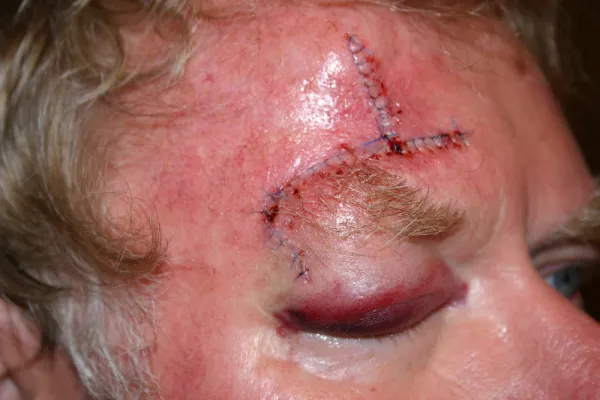Watch Laceration Size and Closure For Accurate Oral Laceration Repair Reporting

Hint: Your diagnosis reporting will not be complete if you fail to identify cause.
When your oral surgeon performs a repair of a laceration to any area of the mouth or the lip, you will need to focus on the anatomical location, the length of the laceration and on the complexity of the closure. These factors will help you to decide upon the code you will report for the procedure performed.
Note That Integumentary Repair Codes Include Mucous Membranes
When reporting a laceration repair that your surgeon performs in the lip area or any other part of the mouth, the choice that seems quite obvious would be to report one of the codes from the following code sets depending on the type of repair and the length of laceration that your surgeon repaired:
Caveat: As the descriptors to the above mentioned codes carry the term “mucous membranes,” it would seem like a right choice to use these codes for any laceration repair that your surgeon performs in the area of the lip or any other part of the mouth. “The type of suture will have an indication on layers of closure and may support the process of selection of the right code for the procedure,” says Barry Shipman, DMD, clinical professor, University of Florida School of Dentistry, Hialeah Dental Center. However, CPT® instructs that for full thickness repairs, you should search the respective anatomical sites in the proper section of the book. So, if there is a specific code that better describes the repair specific to the anatomical site, then you will have to use that code instead. “Anatomy dominates, if you describe the anatomy you should be safe,” Shipman observes.
Substitute With These Codes Specific to Anatomical Site
As mentioned, you will have to use a site specific code to report a laceration when your surgeon performs a full thickness repair in the area of the lip using one of these two codes:
Code 40650 (Repair lip, full thickness; vermilion only) identifies the repair of a laceration that involves the full thickness of the lip and the vermilion border. Code 40652 (Repair lip, full thickness; up to half vertical height) involves a laceration or surgically created wound that extends through the full thickness of the lip, including the vermilion border, whose size extends up to one-half of the vertical height of the remaining lip area.
Similarly, you will have to use one of the following two codes depending on the length of the repair and/ or complexity when your surgeon repairs a laceration in the vestibule of the mouth:
For repair of a laceration in the tongue or the floor of the mouth, you will have to again look at chart notes to see the location, length of laceration/ and or complexity to decide which of these three codes you will report for the procedure:
For repair of palatal lacerations, you should again choose from one of these two codes based on size of the laceration and/ or complexity of the repair:
Discern When to Choose Complex Repair Codes
As most of these laceration repair codes give you the option of having to choose a code based on the complexity of repair, you will need to know how to determine from your surgeon’s chart notes when to pick these codes over simple laceration repair codes.
You will need to report a “complex” repair code when documentation reveals that there has been extensive tissue damage or there is a “crushing” type of injury to the area that is being repaired. Another instance when you will have to base your selection of code to report a complex repair code is when your surgeon performs complex closure (layered tissue closure or use of retention sutures). “The diagnosis of the cause of the laceration is important in making the right choice,” Shipman adds.
The use of irrigation does not increase the complexity of this procedure to allow you to report the procedure as complex. So, if your surgeon performs an irrigation of the area, don’t rush to reporting a “complex” code.
Note: If you are not able to identify from chart notes whether to choose a simple or a complex code, it is best to query your surgeon to see which of the codes is more apt for the procedure that he performed. You might lose out on deserved reimbursement if you fail to identify “complex” repair and report a “simple” repair instead.
Don’t Forget to Report The Appropriate Diagnosis and Causative Codes
When reporting a laceration repair that your surgeon performs, you will also have to report an appropriate diagnosis code to support the medical necessity of performing the procedure. For instance, if the patient has suffered a puncture wound to the mouth, you will have to choose S01.532- (Puncture wound without foreign body of oral cavity).
Note: In ICD-10, certain codes require you to list a seventh character to provide information about the characteristic of the encounter. If you report only six characters for these diagnoses, you’re submitting an invalid code and courting a claim rejection.
When it comes to injuries, you’ll list seventh character “A” for initial encounter, “D” to indicate a subsequent encounter, or “S” to indicate sequela. You report an initial encounter code when the patient presents to your surgeon for the first time or when the patient is under active care for the injury. You report the subsequent encounter code when the patient reports to your surgeon during the healing phase. You choose to report the encounter as “sequela” when the patient presents to your clinician with a complication that is caused due to the injury.
So, in the instance described above, your reporting of the diagnosis will not be complete unless you report it with the specific 7th character that specifies the encounter. Suppose the patient is seeing your surgeon for the repair, you will have to report the diagnosis as S01.532A.
Your reporting of the diagnosis is still not complete if you fail to report the cause of the injury with an additional code. Suppose the patient suffered a lip laceration because he accidentally bumped into someone, you will have to report the cause with the code, W51.- (Accidental striking against or bumped into by another person).
Again, in this case, you’ll see that you need to report seven characters, but the listed code is only three characters long. In situations like this, you should report “x” as the 4th, 5th and 6th characters. In ICD-10, dashes are used to “hold” a character space when you should list a specific character, but you are discussing the code category in general. The “x” character, on the other hand, fills in a space when the code set has no specific characters in certain positions in the code, but the code requires a seventh character.
So, in this case, if the patient is seeing your surgeon for repair of the laceration, you will report W51.xxxA (Accidental striking against or bumped into by another person, initial encounter) which will indicate to the payer that the patient suffered a laceration due to accidental bumping into another person and the patient is being seen by your surgeon for active treatment of the laceration.




